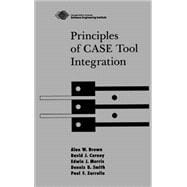
Note: Supplemental materials are not guaranteed with Rental or Used book purchases.
Purchase Benefits
What is included with this book?
| Preface | p. 3 |
| The Problem of Integration in a CASE Environment | p. 9 |
| Introduction | p. 11 |
| Introduction | p. 11 |
| What Is CASE? | p. 12 |
| What Is a CASE Tool? | p. 13 |
| What Is a CASE Environment? | p. 15 |
| Expectations About CASE and the Need for Tool Integration | p. 17 |
| A Hypothetical Example of the Problems of CASE Tool Integration | p. 18 |
| Summary | p. 24 |
| Previous Approaches to Understanding CASE Tool Integration | p. 27 |
| Introduction | p. 27 |
| Conceptual Models of Integration | p. 28 |
| Evolution of Integrated CASE Environment Architectures | p. 36 |
| Summary | p. 45 |
| Toward a Better Understanding of Integration | p. 47 |
| Introduction | p. 47 |
| A New Conceptual Model of Integration | p. 48 |
| Integration as a Design Activity | p. 51 |
| Realizing a Federated CASE Environment | p. 52 |
| Summary | p. 55 |
| Service, Mechanism, and Process Level Integration | p. 57 |
| A Service-Based Model of a CASE Environment | p. 59 |
| Introduction | p. 59 |
| Overview of the PSE Reference Model | p. 61 |
| Description of Reference Model Services | p. 64 |
| Uses of the Reference Model | p. 69 |
| Summary | p. 72 |
| Properties and Types of Integration Mechanisms | p. 73 |
| Introduction | p. 73 |
| Properties of Integration | p. 74 |
| The Relationship Between Data and Control Integration | p. 76 |
| Presentation Integration | p. 78 |
| Summary | p. 80 |
| Data Integration Mechanisms | p. 83 |
| Introduction | p. 83 |
| Key Issues for Data Integration | p. 84 |
| Data Persistence | p. 84 |
| Semantic Mechanisms for Data Integration | p. 89 |
| Other Factors for Data Integration | p. 92 |
| Examples of Actual Integration Mechanisms | p. 94 |
| Summary | p. 105 |
| Control Integration Mechanisms | p. 107 |
| Introduction | p. 107 |
| Integration in a CASE Environment | p. 108 |
| The Message Passing Approach | p. 110 |
| Examples of the Message Passing Approach | p. 113 |
| Discussion | p. 124 |
| Summary | p. 131 |
| The Role of Process in Integrated CASE Environments | p. 133 |
| Introduction | p. 133 |
| Understanding the Nature of Process Integration | p. 134 |
| Process Integration and CASE Tools and Environments | p. 138 |
| Examples of Process and CASE Tool Interactions | p. 142 |
| Summary | p. 147 |
| Practical Experiences with CASE Integration | p. 149 |
| Experiments in Environment Integration | p. 151 |
| Introduction | p. 151 |
| The Integration Experiments | p. 153 |
| Summary | p. 174 |
| Replacing the Message Service in a CASE Integration Framework | p. 177 |
| Introduction | p. 177 |
| Background | p. 179 |
| Getting Started | p. 181 |
| Adding the ToolTalk Interface | p. 183 |
| Running the Experiment Scenario | p. 186 |
| Replacing ToolTalk in the Emulation Framework | p. 187 |
| Lessons Learned | p. 188 |
| Summary | p. 189 |
| Integration of Case Tools with CM Systems: Lessons Learned | p. 193 |
| Introduction | p. 193 |
| Key Concepts Related to CM and Case Tool Integration | p. 195 |
| Case Tool Integration Scenarios Involving CM | p. 202 |
| Summary | p. 212 |
| A Review of the Current State of Case Tool Integration | p. 215 |
| Case Environments in Practice | p. 217 |
| Introduction | p. 217 |
| Background of the Studies | p. 218 |
| Observations | p. 219 |
| An Example of a Transitional Case Environment | p. 233 |
| Case Environment Progress over the Past Decade | p. 235 |
| Summary | p. 236 |
| Summary and Conclusions | p. 239 |
| Introduction | p. 239 |
| Major Themes Discussed | p. 240 |
| How Will Progress Be Made? | p. 243 |
| Final Thoughts | p. 245 |
| References | p. 247 |
| Sample Descriptions of Case Integration Efforts | p. 255 |
| List of Figures | p. 263 |
| List of Tables | p. 267 |
| Index | p. 269 |
| Table of Contents provided by Syndetics. All Rights Reserved. |
The New copy of this book will include any supplemental materials advertised. Please check the title of the book to determine if it should include any access cards, study guides, lab manuals, CDs, etc.
The Used, Rental and eBook copies of this book are not guaranteed to include any supplemental materials. Typically, only the book itself is included. This is true even if the title states it includes any access cards, study guides, lab manuals, CDs, etc.